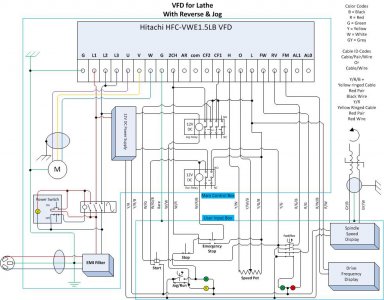The control wiring to VFD's is low voltage. Varies by manufacturer but usually under 30 volts. Most any type switch will do in a pinch. VFD's take a normally open input from a common source of reference. That said you can change to NC operation via programming but why change unless you really need too. Just something else to remember.
What is more important is the type of signal, momentary or maintained. Momentary-pushbutton. Maintained-selector switch. You will have to program the VFD to tell it which type you are using. Pushbutton-3 wire control. Selector switches-2wire control. This activates the internal programming to include a maintaining circuit for the start button. For the sake of safety (my big problem) you should use momentary inputs to forego accidental start on power up unless you are experienced in control wiring and know how to eleviate this potential problem. REASON: If you are operating your machine and there is a power outage, momentary or sustained you do not want the machine to self start upon the return of power. So far we have three pushbuttons. FORWARD. REVERSE. STOP. Next the speed control. This is only a 3 wire resistive reference for the drive so the least expensive route is a trip to radio shack for a rotery potentiometer in the 3K to 10K range. Not critical as this is only a reference input and the drive will know how to handle it. Don't forget to get a knob either, just a finishing touch to your pushbutton enclosure and a switch label if they have one. I am big on neat, professional, looks. After all, you have to look at it from now till forever.
Switches. I really like the 22mm european DIN style. Usually pretty affordable. I don't know your sources but a oil tight 22mm pushbutton with a NO contact block costs me about $9 or less. This size button mounts in a 7/8" punched or drilled hole, 1/2" conduit size so you should not have to buy any more tooling. There are operators available for your speed control to match your PB's but the are horrendiously expensive. In the $65 + range. Oil tite means just that. They are gasketed and sealed against liquid entry into the enclosure be it oil, coolant, water whatever. In other words made for and intended for the purpose. The larger operators use a 1 7/32" hole usually with a square notched locking hole to prevent turning after installation. But they are way more expensive, require a larger enclosure and just aren't as cute as the smaller ones. AB and Telmecinique (SqD) are two very good brands.
There you have it. There are a thousand other ways to do the same job, this is just one. If you need more features like keyed lockouts, jog functions etc we can add anything. As I used to tell my customers, "With your money and my brains, we can do anything!" Boy do I tend to be mouthy.
Get this done so you can start making SWARF.


